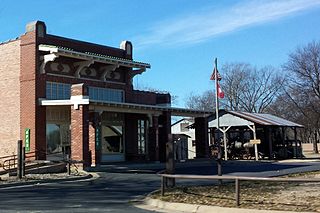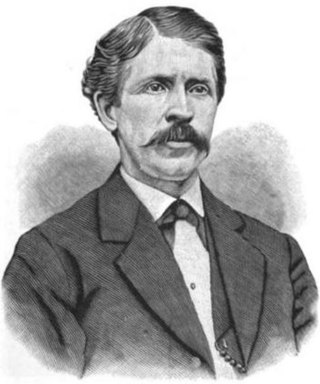
Scott is an unincorporated community and census-designated place (CDP) in Lonoke and Pulaski counties in the central part of the U.S. state of Arkansas. Per the 2020 census, the population was 97. It is part of the Little Rock–North Little Rock–Conway Metropolitan Statistical Area.
The Battle of Helena was fought on July 4, 1863, near Helena, Arkansas, during the American Civil War. Union troops captured the city in July 1862, and had been using it as a base of operations. Over 7,500 Confederate troops led by Lieutenant General Theophilus Holmes attempted to capture Helena in hopes of relieving some of the pressure on the Confederate army besieged in Vicksburg, Mississippi. Helena was defended by about 4,100 Union troops led by Major General Benjamin Prentiss, manning one fort and four batteries of artillery.
The Battle of Bayou Fourche, also known as the Battle of Little Rock, was a battle of the American Civil War fought between Union and Confederate forces on September 10, 1863, in Pulaski County, Arkansas. It was the final battle of the Little Rock Campaign, resulting in the Federal occupation of Little Rock.

John Sappington Marmaduke was an American politician and soldier. He was the 25th governor of Missouri from 1885 until his death in 1887. During the American Civil War, he was a senior officer of the Confederate States Army who commanded cavalry in the Trans-Mississippi Theater.
The Battle of Poison Spring, also known as the Poison Spring massacre, was fought in Ouachita County, Arkansas, on April 18, 1864, as part of the Camden Expedition, during the American Civil War. A Union force commanded by Major General Frederick Steele had moved from Little Rock, Arkansas, in support of Major General Nathaniel Banks's movement along the Red River towards Shreveport, Louisiana. Steele's objective was also Shreveport, and his men occupied Camden, Arkansas. After Banks was defeated at the battles of Mansfield and Pleasant Hill, Steele was isolated in Arkansas. Short on supplies, Steele sent a detachment commanded by Colonel James M. Williams on April 17 to forage for 5,000 bushels of corn that were reported to be in the area.
The Battle of Prairie D'Ane, also known as the Skirmish at Prairie D'Ane, Battle of Gum Springs, or Battle of Moscow, was fought in present-day Nevada County, Arkansas, as part of the Camden Expedition, during the American Civil War. The Camden Expedition was launched by Union forces as part of the Red River Campaign of 1864. U.S. planners envisioned two federal armies converging simultaneously, one force under the command of Maj. Gen. Nathaniel Banks pressing northward up the Red River commencing at Alexandria, Louisiana and the other federal army under the command of Maj. Gen. Frederick Steele driving southwestward from Little Rock, Arkansas. The objective was to press the rebel army of Gen. E. Kirby Smith back upon the rebel stronghold at Shreveport and defeat him. If successful, a somewhat vague second phase envisioned the two federal armies combining into one large force and continuing their offensive with a westward push into Texas.
The Camden Expedition was the final campaign conducted by the Union Army in south Arkansas during the Civil War. The offensive was designed to cooperate with Major-General Nathaniel P. Banks' movement against Shreveport.

During the American Civil War, Arkansas was a Confederate state, though it had initially voted to remain in the Union. Following the capture of Fort Sumter in April 1861, Abraham Lincoln called for troops from every Union state to put down the rebellion, and Arkansas along with several other southern states seceded. For the rest of the civil war, Arkansas played a major role in controlling the Mississippi River, a major waterway.
The 36th Iowa Infantry Regiment was an infantry regiment that served in the Union Army during the American Civil War.
8th Missouri Cavalry Regiment was a cavalry unit from Missouri that served in the Union Army during the American Civil War. The regiment was formed between 6 August and 15 September 1862. The regiment fought at Prairie Grove and Van Buren in 1862. The unit participated in Frederick Steele's expedition to Little Rock in 1863, fighting at Brownsville, Bayou Meto, and Bayou Fourche. From 1863 to 1865, the regiment remained in Arkansas, going on expeditions to suppress Confederate raiders and other occupation duties. The unit was mustered out of service on 20 July 1865. In January 1863, the regiment committed what has become known as the Huntsville Massacre.
The 30th Arkansas Infantry (1862–1865) was a Confederate Army infantry regiment during the American Civil War. This regiment was also called the 5th Arkansas Cavalry, the 5th Trans-Mississippi Regiment or 39th Regiment after April, 1863. This regiment was converted to mounted infantry for Price's Missouri Expedition in 1864 and was known as Rogan's Arkansas Cavalry. There were two regiments officially designated as the 30th Arkansas Infantry. The other 30th Arkansas served east of the Mississippi River and was redesignated as the 25th Arkansas Infantry.
The 5th Arkansas Cavalry Regiment (1863–1865) was a Confederate Army cavalry regiment during the American Civil War. The regiment was designated at various times as Newton's Regiment Arkansas Cavalry, Morgan's Regiment Arkansas Cavalry, 2nd Regiment Arkansas Cavalry, and the 8th Regiment Arkansas Cavalry. This regiment should not be confused with a later regiment commanded by Col. Robert Crittenden Newton, which was a regiment of Arkansas State Troops usually referred to as Newton's 10th Arkansas Cavalry Regiment.
The Battle of Brownsville was fought on August 25, 1863, near what is now Lonoke, Arkansas, between Union forces led by Colonel Washington Geiger and Confederate troops under Brigadier General John S. Marmaduke. Union forces commanded by Major General Frederick Steele were advancing from Helena, Arkansas, towards Little Rock, the state capital of Arkansas. Confederate Major General Sterling Price ordered cavalry led by Marmaduke and Brigadier General Lucius M. Walker to Brownsville in response to the Union advance.

The Battle of Bayou Fourche saw Union forces under the overall command of Frederick Steele clash with Confederate forces led by Sterling Price near Little Rock, Arkansas. The only fighting occurred when Steele's cavalry commanded by John W. Davidson crossed to the south side of the Arkansas River and compelled the Confederate cavalry under John S. Marmaduke to abandon its defensive position behind Bayou Fourche. Price's outnumbered forces evacuated Little Rock and withdrew south to Arkadelphia. The Union occupation of Little Rock was the final action in a campaign that started on August 18 when Steele's troops marched west from DeValls Bluff.
The 3rd Missouri Cavalry Regiment was a cavalry regiment of the Confederate States Army during the American Civil War. It was also known as Greene's Regiment after its commander, Colonel Colton Greene.

The Springfield Illinois Light Artillery, also known as Vaughn's Independent Illinois Battery or Battery A, 3rd Illinois Light Artillery, was an artillery battery from Illinois that served in the Union Army during the American Civil War. Organized in August 1862, the unit was first stationed at Bolivar, Tennessee. In August–September 1863 the battery participated in Frederick Steele's expedition to Little Rock, Arkansas, being engaged at Bayou Fourche. In spring 1864, the battery took part in the Camden Expedition, fighting at Prairie D'Ane and Jenkins' Ferry. The unit sat out the remainder of the war in Little Rock before being mustered out of service in June 1865.
The 13th Missouri Cavalry Regiment was a cavalry unit that served in the Confederate States Army during the American Civil War. In early April 1863, Captain Robert C. Wood, aide-de-camp to Confederate Major General Sterling Price, was detached to form an artillery unit from some of the men of Price's escort. Wood continued recruiting for the unit, which was armed with four Williams guns, and grew to 275 men by the end of September. The next month, the unit fought in the Battle of Pine Bluff, driving back Union Army troops into a barricaded defensive position, from which the Union soldiers could not be dislodged. By November, the unit, which was known as Wood's Missouri Cavalry Battalion, had grown to 400 men but no longer had the Williams guns. In April 1864, Wood's battalion, which was also known as the 14th Missouri Cavalry Battalion, played a minor role in the defeat of a Union foraging party in the Battle of Poison Spring, before spending the summer of 1864 at Princeton, Arkansas. In September, the unit joined Price's Raid into the state of Missouri, but their assault during the Battle of Pilot Knob failed to capture Fort Davidson.
The 10th Texas Field Battery was an artillery battery that served in the Confederate States Army during the American Civil War. After being formed in early 1861 by Benjamin H. Pratt, the battery served with a cavalry formation led by Colonel William Henry Parsons for part of 1862. It was called upon to enter Missouri in support of troop movements related to the Battle of Prairie Grove, but this did not occur. It then operated along the Mississippi River in early 1863, harassing enemy shipping. The unit then participated in Marmaduke's Second Expedition into Missouri and the Battle of Pine Bluff in 1863. Late in 1864, the battery, now under the command of H. C. Hynson, served in Price's Raid, participating in several battles and skirmishes, including the disastrous Battle of Mine Creek. One source claims the unit's service ended on May 26, 1865, while a Confederate report dated June 1, 1865, states that it existed but did not have cannons. Confederate forces in the Trans-Mississippi Department surrendered on June 2.

On September 6, 1863, near Little Rock, Arkansas, a duel was fought between John S. Marmaduke and Lucius M. Walker, two generals in the Confederate States Army. Tension had risen between the two officers during the Battle of Helena on July 4, 1863, when Marmaduke accused Walker of not supporting his force, and then retaliated by not informing Walker of a Confederate retreat. Marmaduke was later assigned to serve under Walker during a Union advance against Little Rock. Walker did not support Marmaduke during a retreat after the Battle of Brownsville, and Marmaduke questioned Walker's courage after the Battle of Bayou Meto on August 27. A series of notes passed between the two generals by friends resulted in a duel, during which Marmaduke fatally wounded Walker. Marmaduke was arrested and charged with murder but was soon released, and later the charge was dropped. He survived the war and later became Governor of Missouri. Union forces captured Little Rock later in the campaign, after the Battle of Bayou Fourche.
The Little Rock Campaign, officially known as Advance of the Union forces upon Little Rock, Arkansas, was a campaign conducted by the Union Army in Arkansas during the American Civil War. The strategic offensive was designed to capture Little Rock.








